![]()
![]()
![]()
Use LEFT and RIGHT arrow keys to navigate between flashcards;
Use UP and DOWN arrow keys to flip the card;
H to show hint;
A reads text to speech;
29 Cards in this Set
- Front
- Back
|
1a)i) Yeast reproduces asexually by a process called budding. During this process, cell division occurs. Name the type of cell division that occurs in asexual reproduction (1) |
mitosis |
|
|
1a)ii) Before the division of the nucleus of a cell, the genetic material must replicate. Explain why this is essential. (2) |
idea that:cells, genetically identical / have same DNA; so both (daughter) cells receive a full, copy/complement ; allow 'daughter cells have all the identical genetic material' for 2 marks |
|
|
1b) Unlike yeast, the nuclei of most eukaryotic organisms contain homologous pairs of chromosomes. Explain what is meant by a homologous pair of chromosomes. (3) |
1 one maternal and one paternal / AW; 2 carry same genes; 3 carry, same / different, alleles; 4 (usually) same / similar, length; 5 centromere in same position; 6 same banding pattern; 7 pair up in meiosis / form bivalent; 3 max |
|
|
1c)i) State what is meant by the term tissue (2) |
a, group / collection, of cells; (cells) specialised / AW; to perform a function(s) / working together; 2 max |
|
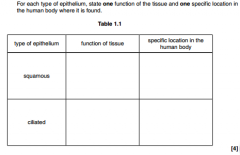
1c)ii) |
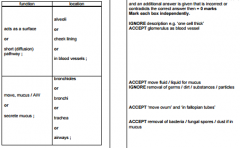
|
|
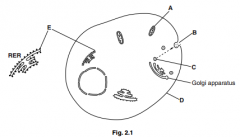
2a)i) Name the structures labelled C, D and E (3) |
C (secretory / Golgi) vesicle; D plasma membrane or cell surface membrane; E ribosome; |
|
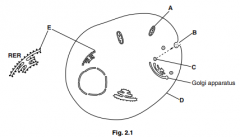
2a)ii) suggest one type of extracellular protein secreted at B (1) |
enzyme/(peptide) hormone/glycoprotein; ACCEPT named example e.g. insulin, mucus, cytokine,antibodies, collagen IGNORE haemoglobin, histamine, steroid hormones e.g.testosterone |
|
|
2a)iii) Suggest one stage during the secretion of a protein that requires energy. (1) |
transport vesicles to, plasma/cell surface, membrane; fusing vesicle to membrane/exocytosis ; 1 max |
|
|
2a)iv) Outline the role of the Golgi apparatus (2) |
1 receives proteins from the, (R)ER/ribosomes;2 modify/process, proteins or make glycoproteins/ add named molecule(s)/described; 3 (re)package/AW, into vesicles;4 make lysosomes;5 replenishes, plasma/cell surface, membrane;6 lipid synthesis; 2 max modifies and packages proteins into vesicles = 2 marks |
|
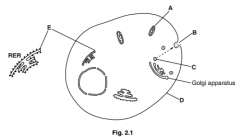
2b)i) Identify two features, visible in Fig.2.1, which would not be present in a prokaryotic cell. (2) |
nucleus or nuclear, envelope/pore/ membrane;mitochondrion/mitochondria; (rough / smooth) endoplasmic reticulum/ER OR ribosomes attached to membrane; Golgi (body / apparatus); (secretory) vesicle(s); 2 max |
|
|
2b)ii) Name one feature that would be present in the cytoplasm of a prokaryotic cell that is not found in a eukaryotic cell. (1) |
(free / circular / naked) DNA / genetic material / nucleoid; plasmid; 18nm/70S/smaller, ribosomes; 1 max |
|

3a) |
double circulatory system, closed circulatory system. Bottom right. |
|
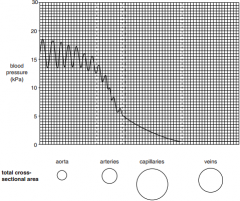
3b)i) The pressure fluctuates as the blood flows along the aorta, as shown in Fig.3.1. Explain what causes this fluctuation (2) |
systole / contraction, increases pressure;diastole / relaxation/ blood flowing onwards, decreases pressure;(contraction of) ventricle, muscle / wall;left (ventricle); 2 max ‘contraction of left ventricle’ = 1 mark‘contraction of muscle in left ventricle’ = 2 marks‘ventricular systole increases pressure’ = 2 marks |
|
|
3b)ii) State the term used to describe the number of fluctuations per minute (1) |
pulse / heart, rate ; |
|
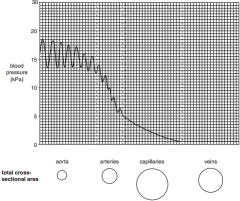
3c) Using the information in Fig.3.1 describe the pressure changes in the blood as it flows through the circulatory system from the aorta to the veins. (3) |
marks for pressure change:pressure drops, as distance from heart increases;greatest/rapid/significant, pressure drop while blood is in the arteries;pressure, constant / does not drop, in veins; marks for amplitude of fluctuations:fluctuation / AW, decreases from aorta to arteries;no fluctuation in, capillaries / veins; use of comparative figures with unit; 3 max |
|
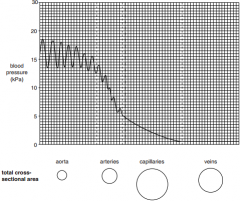
3d)i) using the information in Fig3.1, explain what causes the overall change in pressure as blood flows from the aorta to the arteries and from the arteries to the capillaries (2) |
blood flows into larger number of vessels; (total) cross-sectional area of the arteries is greater than the aorta; (total) cross-sectional area of the capillaries is greater than the, aorta / arteries; ignore ref to lumen size 2 max |
|
|
3d)ii) Explain why it is important that the presure changes as blood flows from the aorta to the capillaries (2) |
capillary (wall) is, thin / only one cell thick; (high pressure would) burst / damage, capillary (wall); reduce chance of, tissue fluid build up/oedema; 2 max |
|
|
4a)i) A student wanted to observe some red blood cells under the microscope. The student placed a small sample of blood onto a microscope slide and added a drop of distilled water. When viewed at high power, the student observed that the red blood cells had burst. In a similar procedure using plant epidermis, the student observed that the plant cells did not burst. Explain these observations QWC (5) |
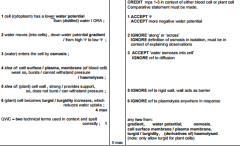
|
|
|
4a)ii) Suggest how the student could modify the procedure to observe red blood cells without them bursting (1) |
use a, salt / sugar, solution OR add solute to water; use a solution with the, same / similar / lower, water potential as blood cells ; 1 max |
|
|
4b) Oxygen enters red blood cells as they pass through the capillaries in the lungs. Name the mechanism by which oxygen enters the red blood cells. (1) |
diffusion do not credit facilitated diffusion |
|
|
4c) The cells in the epidermis of a plant root are specialised to absorb minerals from the surrounding soil. State the process by which root epidermal cells absorb minerals from the soil and describe how these cells are specialised to achieve absorption. (3) |
1 active, transport / uptake; plus any two from: 2 cells have, extensions/hairs; 3 thin cell wall; 4 large/increased, surface area; 5 many/more, mitochondria; 6 (many) carrier proteins in cell (surface) membrane ; 3 max |
|
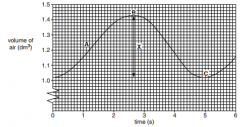
5a)i) Name the measurement represented by the line X (1) |
Tidal volume |
|
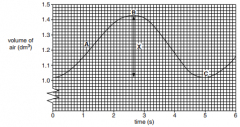
5a)ii) What is happening to the elastic fibres in the walls of the alveoli at point A (1) |
being stretched/stretching; ACCEPT lengthening |
|
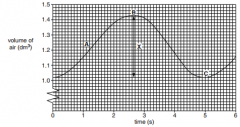
5b) Explain what causes the change in the volume of air between points B and C QWC (4) |

|
|
|
5c) Using Fig5.1, calculate the breathing rate of this student in breaths per minute (2) |
12 |
|
|
5d) about 1dm^3 of air cannot be expelled from the lungs. This is known as the residual volume. Suggest why it is not possible to expel all the air from the lungs (2) |
idea that:thorax / rib cage / lungs, cannot be completely , compressed / flattened; trachea / bronchi, held open by cartilage; bronchioles / alveoli, held open by elastic fibres;AVP; 2 max |
|
|
6a)i) Name the sugar most commonly transported through the stem of a plant and the tissue that transports this sugar. (1) |
sucrose and phloem |
|
|
6a)ii) Sugar molecules are actively loaded into the transport tissue. Describe how active loading takes place. (3) |
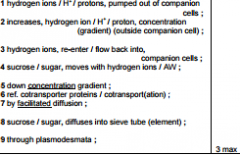
|
|
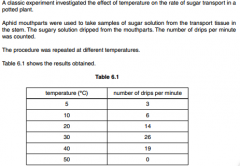
6b) Suggest brief explanations for these results. (3) |
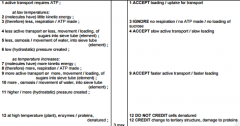
|

